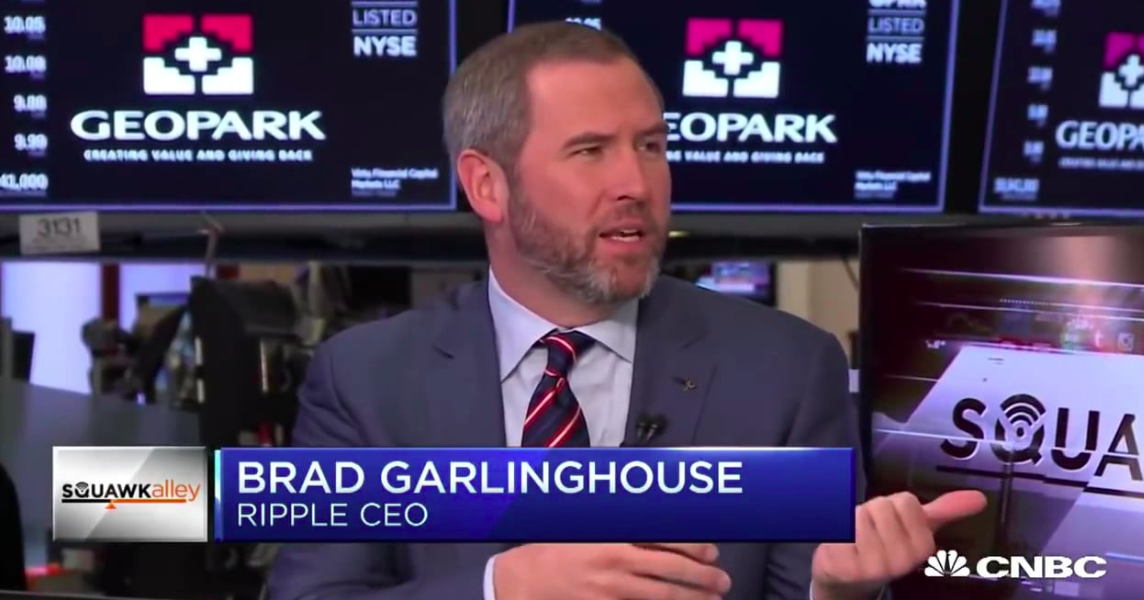In mid-2017, Ripple Labs finally had the wind in its sails. A few months earlier, it had secured a $50 million Series B funding round, and was starting to get high on the crypto vibe. But most importantly of all, it had finally come up with its master plan for disrupting banking.
Ripple’s first attempts at disrupting banking
The first four years of Ripple Labs’ existence had been rough. Its original plan was to disrupt finance by selling the Ripple coins it had created out of thin air and given to itself:
Unfortunately, the FinCEN got wind of Ripple’s ingenious plan, and attacked them, trying to kill the revolution in the egg. Ripple got fined for acting as a money serving business without proper processes in place, or registering with the FinCEN.
Ripple thought that it had learned a lesson: if you want to disrupt, you have to play nice with the dinosaurs. In 2015, it tried to go and sell its decentralised ledger technology to SWIFT, the bank-owned company specialising in interbank transactions.
At the time, SWIFT was already feeling the winds of change, and understood that the new, revolutionary blockchain technology was a death threat to its cozy, old man’s monopoly. SWIFT got a glimpse at Ripple’s technology, (probably) stole at least three or four ground-breaking ideas, and then pushed them away, coming up with a pretence of an excuse:
“You still need business rules on top of that and you still need the payment information anyway. That’s not in a distributed ledger technology, at least not today.”
Wim Raymaekers, global head of banking markets at Swift, 2015
Two years later, in March 2017, Ripple tried again. The old banking guard could finally no longer hide the fact that it was hopelessly left behind, and had to do something. Ripple got a gig with none other than the Bank of England, one of the oldest and most respected central banks in the world. Brad Garlinghouse, the company’s CEO, couldn’t feel any more excited:
Proud of @Ripple’s continued work with @bankofengland, and being chosen for its #FinTech Acceleratorhttps://t.co/IAHP6hlxie
— Brad Garlinghouse (@bgarlinghouse) March 17, 2017
However, just as SWIFT, the BoE simply used the “partnership” trick to (probably) steal some technological secrets, and cut short its experiment with Ripple within a few weeks. The only trace of its interaction with the revolutionary startup is, to this day, a short notice in a section titled “Firms we have worked with in the past”, on its “Fintech proofs-of-concept” page.
Ripple decides to change the world on its own
Ripple had had enough of the old and dying banking dinosaurs tricks and lies. If it wanted to change the world, it had to do it on its own. The company devised its new winning strategy: forget about the banking dinosaurs, and try to win over the masses of unsophisticated retail investors.
First, to get some traction, the company set up a slush fund to pay companies to become its partners, and to put out positive news releases about their partnerships with Ripple. Costs didn’t matter - Ripple was ready to pay prospective partners up to three times the costs those would incur while testing Ripple’s solutions.
Then, Ripple reached out to every company in the world, no matter how small or irrelevant. Even non-existing companies made the cut, like SendFriend, which Ripple financed with its slush fund so that it could try and start its operations. And it worked: enticed by the prospect of free money, more and more companies agreed to say publicly that they were using Ripple’s technology.
Finally, Ripple built a team of online cheerleaders, ready to like and retweet any statement and press release, and crush any criticism, creating an appearance of wide acclaim and success. The team would be known as the XRP Army, and its allegiance to Ripple Labs became legendary - as much online, where the XRP Army would applaud any brainfart from the company’s C-suite:
… as in the real world:
David Schwartz, Ripple Labs’ current CTO, and Tiffany Hayden, leader of the XRP Army, “not an employee of Ripple” according to her Twitter profile Brad Garlinghouse, Ripple Labs’ CEO, and Tiffany Hayden, leader of the XRP Army, “not an employee of Ripple” according to her Twitter profile
The XRP Army would become a cornerstone of Ripple Labs’ communication strategy, ready to broadcast any misleading or false message intended to pump up the price of XRP coins, without exposing the company to accusations of fraud.
La revolution est en marche
Just in time! As old-school news outlets finally woke up to the crypto revolution in mid-2017, they could no longer ignore Ripple Labs, with its growing list of partnerships. In September 2017, Mr Garlinghouse managed to secure an interview with Forbes, where he got the chance to explain how Ripple was going to disrupt inter-bank transactions.
Out of the gate, he hit the nail on its head:
“If I want to move money from here (San Francisco) to London, the fastest way is to fly there.”
Brad Garlinghouse, CEO of Ripple Labs
Indeed, SWIFT gpi, the solution all the banks were queueing up to use at the time as it allowed them to transfer money in under 30 minutes to anywhere in the world, didn’t actually move any money. All it did was to set up a communications channel between banks where they could exchange all transfer-related information, like KYC and AML documents, account numbers, and the like.
Brad Garlinghouse made it crystal clear: Ripple was all about actually moving value. The only way banks could do it, was to load planes up with banknotes, and fly them to another country. Ripple was going to do it better. This message stuck with the Ripple community, and is still being broadcasted, two years later, by its most energetic members like @XRPTrump:
it’s not important what settlement method is used, the collateral has to move PHYSICALLY. in XRP it’s DIGTAL. You know this. everyone knows this. Cash can be flown in planes today, current system didn’t replace that option, XRP won’t replace today’s optionhttps://t.co/L2poQ0w9nP
— Dr. T ㊙️ (@XRPTrump) February 3, 2019
Then, Mr Garlinghouse dealt another blow to the rotten banking cartel. He revealed that the overall number of banks wasn’t declining because the Internet made the old retail banking model of a wide network of small regional branches obsolete. No, the CEO of Ripple Labs put the naked truth out there for everyone to see: the number of banks was declining because correspondent banking was killing them.
“The existing model of correspondent banking has its problems. The number of correspondent banks around the world dropped by roughly 50 percent over the last 15 years, from 28,000 to about 12,000.”
Brad Garlinghouse, CEO of Ripple Labs
Finally, Mr Garlinghouse saw beyond the definition of bank capital (assets minus liabilities, whatever the assets or the liabilities), to introduce a new concept of “bank capital”:
“Post crisis people are more aware of dormant capital, such as nostro yen accounts in Tokyo that because of regulatory change can no longer count toward my capital ratios in the U.S.”
Brad Garlinghouse, CEO of Ripple Labs
Unfortunately, he didn’t have the time to explain his new concept of bank capital during the interview, or ever since.
Behind the scenes, blueprints are being brought to life
While Mr Garlinghouse was going out into the spotlight, winning over the hearts of unsophisticated retail investors with all his banking knowledge, his colleagues at Ripple Labs were working behind the scenes, explaining in more detail Ripple’s grand plan for overthrowing the rotten banking cartel:
“Ripple is actively pursuing strategies (such as xRapid) that allow XRP to act as a settlement currency without requiring financial institutions to hold XRP. Ensuring that there is sufficient market making to allow XRP liquidity into key corridors is also one of those strategies.”
David Schwartz, current Ripple Labs’ CTO and creator of the XRP coin
And there it was, Ripple’s solution to the problem of not being able to move value around: the XRP coin. In a matter of months, Ripple had invented the concept of “settlement currency”, a virtual magic coin that existed only in Ripple’s databases, backed by nothing, worth whatever people were willing to pay for it. The foundations of the new financial order were set.
How would it work in practice? Look no further than this Youtube video with Ripple’s SVP of Product Asheesh Birla:
Ripple’s groundbreaking idea for doing payments was simple:
- Bank A buys XRP coins on a local exchange (Bittrex in the example) with the cash (USD) it needs to send
- Bank A sends these coins, by changing their ownership entry in the global Ripple database, to an exchange in the country of destination (Bitso)
- Bank A instructs that exchange to sell XRP coins for fiat currency (MXN), and deliver that currency to Bank B.
The main advantages of this system versus SWIFT gpi are:
- Instead of having accounts with each other and the central bank, banks would have accounts with each other, the central bank, AND the country’s XRP exchanges, where they would store hundreds of billions of dollars’ worth of fiat currencies in order to be able to face one-minute withdrawals, creating massive single points of failure.
- Instead of setting up country-to-country payment channels, like SWIFT gpi does (because each country has its own laws regarding KYC and AML, and standards have to be written in code as to what documents need to be provided along with the transaction), Ripple would leave all this trouble to the banks and to the exchanges, who would have to figure out for themselves what documents they need for every transaction, for every country in the world.
- Whenever an exchange would get hacked and all its XRP would be stolen, everyone would know immediately that it’s bankrupt, and there would be no way to get back the stolen XRP coins because remember - Ripple doesn’t control or is associated with XRP in any way, it’s just that they happen to own the majority of it, because they created it out of thin air and gave it all to themselves.
- The cost of transactions would have to be mind-numbingly high to compensate for the mark-to-market risk of holding XRP, whose price fluctuates wildly as it’s determined by nothing but market flows. The day Ripple runs out of money in its slush fund to subsidise market makers and exchanges, the price of Ripple-powered transactions would shoot through the roof.
And here comes Ripple’s real master plan: to destroy the financial system, so that someone else would have to rebuild it from scratch, Fight Club - style.
In the meantime, helped by the support of the XRP Army, Ripple would pump and dump as much XRP coins as possible, making a fortune on the backs of unsophisticated retail investors.
The moment when the spark lit the flame
As I was about to publish this post, an anonymous source sent me an exclusive video of the exact moment Ripple’s masterminds came up with their plan. The video captures the spark that ignited the flame of financial genius, and shows the precise instant that changed the world, in all its raw glory.
Ready?
Here it goes.

